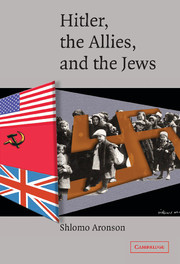Book contents
- Frontmatter
- Contents
- Preface
- Acknowledgments
- List of Abbreviations
- PART I THE MAKING OF THE MULTIPLE TRAP
- PART II THE RESCUE DEBATE, THE MACRO PICTURE, AND THE INTELLIGENCE SERVICES
- PART III THE SELF-DEFEATING MECHANISM OF THE RESCUE EFFORTS
- PART IV THE BRAND–GROSZ MISSIONS WITHIN THE LARGER PICTURE OF THE WAR AND THEIR RAMIFICATIONS
- PART V THE END OF THE FINAL SOLUTION: BACK TO HOSTAGE-TAKING TACTICS
- 32 The Train
- 33 The Bombing Controversy – Speer and Zuckerman
- 34 The “Great Season”
- 35 Becher, Mayer, and the Death Marches
- 36 The “End” of the Final Solution – Budapest
- Epilogue: Self-Traps: The OSS and Kasztner at Nuremberg
- Notes on Sources
- Selected Bibliography
- Index
35 - Becher, Mayer, and the Death Marches
Published online by Cambridge University Press: 22 July 2009
- Frontmatter
- Contents
- Preface
- Acknowledgments
- List of Abbreviations
- PART I THE MAKING OF THE MULTIPLE TRAP
- PART II THE RESCUE DEBATE, THE MACRO PICTURE, AND THE INTELLIGENCE SERVICES
- PART III THE SELF-DEFEATING MECHANISM OF THE RESCUE EFFORTS
- PART IV THE BRAND–GROSZ MISSIONS WITHIN THE LARGER PICTURE OF THE WAR AND THEIR RAMIFICATIONS
- PART V THE END OF THE FINAL SOLUTION: BACK TO HOSTAGE-TAKING TACTICS
- 32 The Train
- 33 The Bombing Controversy – Speer and Zuckerman
- 34 The “Great Season”
- 35 Becher, Mayer, and the Death Marches
- 36 The “End” of the Final Solution – Budapest
- Epilogue: Self-Traps: The OSS and Kasztner at Nuremberg
- Notes on Sources
- Selected Bibliography
- Index
Summary
Kasztner was not the only Jewish personality who had approached the Germans hoping to “deal” with them, but the ultra-orthodox Sternbuch brothers, representing an orthodox rabbinical group in America and situated in Montreux, Switzerland, also tried to deal with them. We are told by Randolph Braham that the ultra-orthodox Rescue Committee, headed by the Sternbuch brothers, worked on a giant rescue effort that was supposed to allow 750,000 Jews to leave Europe; this effort with Himmler, in which the Sternbuchs acted through the former Swiss Federal President, Jean-Marie Musy, was supported by a variety of personalities, such as the right-wing Zionist businessman Dr. Ruben Hecht.
In the meantime, on December 1, 1944, the second “Kasztner Train” from Bergen-Belsen, carrying about 1,328 Jews who had left Budapest five months before, was allowed to cross the border to Switzerland in connection with money payments made by Hungarian Jewry itself, of which Kasztner remained in debt of about $65,000 (U.S.), according to his 1945 report. This was done in the framework of the “Becher–Kasztner” line, stressing a certain economic quid pro quo but one that required more sums and goods to be supplied by the Allies.
In the January meeting between Musy and Himmler, so we are told by Schellenberg, the following decisions were arrived at thanks to Himmler's “active intervention”: First, every fortnight one train with about 1,200 Jews would leave for Switzerland, travel conditions, food, and so on. “to be as good as possible.”
- Type
- Chapter
- Information
- Hitler, the Allies, and the Jews , pp. 304 - 311Publisher: Cambridge University PressPrint publication year: 2004

